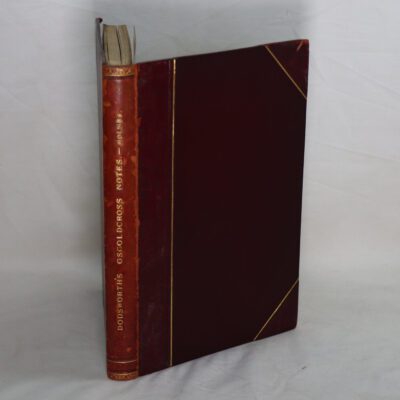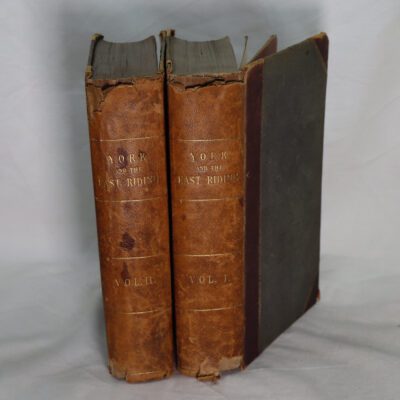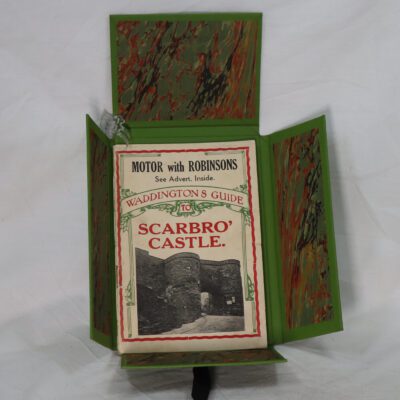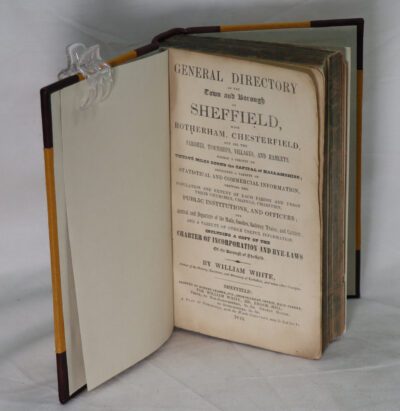The search for your perfect item starts here ...
Bass, Ratcliff & Gretton Excursion to Scarborough.
Printed: 1977
Publisher: The Bass Museum.
| Dimensions | 14 × 21 × 0.5 cm |
|---|---|
| Language |
Language: English
Size (cminches): 14 x 21 x 0.5
Condition: Fine (See explanation of ratings)
Item information
Description
Blue card binding with black and white title on the front board.
-
F.B.A. provides an in-depth photographic presentation of this item to stimulate your feeling and touch. More traditional book descriptions are immediately available.
Note: The £5.00 discount to those that subscribe to the F.B.A. mailing list.
Set in 1914: This highly detailed programme for a Bass brewery outing by train to Scarborough, dated Friday July 24th 1914. The programme’s 40 pages describe in detail the transportation arrangements, places of interest and amusements on offer in Scarborough and attractions to which free or discounted entry was available to excursion ticket holders. There are also a number of illustrations.
Produced on the eve of the First World War, this gives an insight into life and leisure in Britain before the strain and social upheaval of war began to take effect.
The Bass Excursions were a series of works outings laid on for the entire workforce of the Burton-on-Trent brewing firm of Bass, Ratcliff & Gretton. They took place every summer, and ran from the 1860s until 1914. The last one, to Scarborough, took place just weeks before the outbreak of the First World War. The excursions, which were originally just for workers, quickly expanded to include wives and children, along with managers and suppliers. So many townspeople were included that, on the day, the town’s population of 50,000 was reduced by nearly a fifth. Workers travelled free – with family members at a greatly reduced rate – and were given their day’s wages, plus extra pocket money of a half crown to a guinea, depending on their status. Once there, production of their excursion ticket allowed free entrance to all the resort’s attractions.
Organisation: Up to seventeen special trains were engaged to take between 7,000–10,000 workers and their families. There were departures every ten to fifteen minutes, with some workers having arrived at their destination while others were still waiting at Burton station to board their allotted train. The 1904 excursion to Liverpool, for instance, consisted of seventeen trains, the first leaving at 4 a.m., the last at 6.50 a.m. By that time those on the 4 a.m. departure had already arrived at Liverpool Central. The last of the departures – composed entirely of first class dining saloons – was reserved for company executives, along with friends and guests
Brochures: All excursionists were given an illustrated brochure, some containing up to 96 pages. The contents detailed the attractions of their destination, advice on places to eat (and nannyish reminders about the wisdom of a proper meal) . Discounts were available for the excursionists on presentation of their tickets. Additional outings and cruises were available. In addition there was lots of ‘trivia’ – a typical excursion could involve up to 250 carriages, for which two miles of sidings would be required at the destination town. There were facts and figures about rolling stock and locomotives, remarks about the stations and sights passed en route.
The brochures also served as a guide on travel etiquette, reminding passengers to travel only on their designated train, to ensure that compartments were fully utilised and not ‘hogged’. In 3rd class this meant eight to ten in each compartment. Passengers were reminded not to throw bottles out of the window or to leave orange peel on the platforms. When all trains had arrived safely at their destination, Bass’s Traffic Manager, William Walters, personally sent a telegram to Burton-on-Trent to confirm it.
Culture: Many people, both excursionists and those at their destination, good-humouredly referred to the invasion as ‘Bass buying the town.’ ‘And the town is glad to be bought by such generous people,’ said one Yarmouth businessman. ‘Hundreds of them will stay for the week and are amongst our most welcome visitors.’
Incidents and accidents: In 1901 a young maltster employed by Bass was found dead near the tracks just outside Melton Mowbray. After hearing from fellow passengers on the Yarmouth train, an inquest jury agreed that the man’s injuries had been consistent with falling from a train, but could not decide whether it had been an accident or something more sinister. Three years earlier, during the Scarborough trip of 1898, a Bass worker was drowned in a freak accident.
Post-1914: The 1915 excursion to Blackpool had to be cancelled. The demands of the war and mobilisation of troops meant that the railway companies were simply unable to handle a non-priority operation requiring the use of twenty trains. The workers were still allowed their holiday and mostly stayed at home in Burton-on-Trent
William Walters: The man responsible for the Bass excursions retired at the end of 1915 – aged 74. He had overseen the annual trips ever since the first one in 1865, which he organised at the personal behest of William Bass. The first trip – to Liverpool – had been for men and boys only, families not being allowed to go until a later date.
Want to know more about this item?














